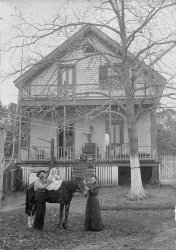
MAY CONTAIN NUTS

Search Shorpy
SHORPY ART

Framed or unframed, desk size to sofa size, printed by us in Arizona and Alabama since 2007. Explore now.
Join and Share
Ad-Free Shorpy
Shorpy is funded by you. Patreon contributors get an ad-free experience.
Learn more.

Recent comments
- Recent view
- Hudson’s Big Store
- Say what??
- Grapes?!
- A Beautiful Moment
- Such joy
- Bethune-Cookman University today...
- Yellow sky at morning
- Side Winder
- Air Quality?
- Sojourner Truth riot
- None were so blind(ed)
- The less famous sister
- Good ol' days?
- Rise and Fall
- Goo Goo Ga Joob
- Ticket Retention
- Not the only one
- Vagaries of War
- Killed by Amtrak
- Back to the Future
- Wanted --
- If you can't stand the light
- Centralized Traffic Control, I believe
- What's really happening
- Heckuva remote control!
- Sometimes — Things Go Bump!
- I SEE THE LIGHT
- Union Switch and Signal Company
- Get That Light Out Of My Eyes
Member Photos
The Shorpy
Print Emporium
Print Emporium
Search Shorpy
Search results -- 30 results per page
- Kelly's Klipper: 1942
- ... that guy in the middle, beside Grumpy Girl: he could be a blacksmith. And the hair! The ‘do on Mr. 1945 looks like a delicious ... Posted by Dave - 05/17/2019 - 5:55pm -
![Kelly's Klipper: 1942 May 1942. Washington, D.C. "Student's car in front of University Club on K Street N.W." Medium format negative by John Ferrell for the Office of War Information. View full size.
Old in 1942Funny they considered this Model A Ford an old car in 1942, when it was only 13 or 14 years old. Automobile style and technology had certainly changed a lot in those years. Lots of cars from 2005 and 2006 (and much older!) on the road today, and they certainly don't stand out.
By the looks of himSecond from the left sure looks like he knows his way around a set of knuckles.
Old, schmoldAt its most venerable, that "old" ride would be the equivalent of a 2007 model today ... in chronological terms. Technologically, those years between 1927 and 1942 brought many changes to even low-price cars, most notably synchromesh transmissions and hydraulic brakes, though Ford was the last of the Majors to adopt the latter.
Now in the aesthetics of style, it's a different story!
Coining a phraseDon't laugh, it's paid for.
Time TravellingMike Wallace interviews local students on car slogans for next episode of "60 Minutes".
Real menThe average group of male college students nowadays would, I’m afraid, look more like boys than these men. Check that guy in the middle, beside Grumpy Girl: he could be a blacksmith. And the hair! The ‘do on Mr. 1945 looks like a delicious pastry.
What a difference.Imagine, they wrote "love you all" on the back fender. Today you can imagine the sophomoric, lewd and crude things / writing they would be putting on, or hang on their cars
1945?Puzzling, the "1945" on the sweater in 1942, was he an earlier Dr. Who?
[So you think those sweaters are like calendars? You've never been in college! - Dave]
No, I live in Australia. We did not have anything like that.
My Dad? Nope, can't be.My father was a student at GW and bore a fairly close resemblance to the guy with the tie in this photo. But my father's college career was interrupted by WWII and he wasn't anywhere near D.C. in 1942. When he finally was able to resume his studies (in 1947) he became one of the older Delta Tau Delta pledges in history, lived in the basement of the frat house on 22nd St NW, and was called "Pops" or "Gramps" by one and all.
I wonder if he ever hung near the University Club? I'd like to think so.
More Friendly Than They LookThe powerfully-built gent in the center is not a GWU student. The others congenially invited him to take a break from the project visibly underway on the right and join in their photo. What else would explain that apparently abandoned toolbox?
[Um, the explanation would be that the toolbox belongs to any of the billion or so people who aren't in the photo. - Dave]
Oh the irony!They wrote: "Don't laugh, you will be old too!"
(The Gallery, Cars, Trucks, Buses, D.C., John Ferrell)](https://www.shorpy.com/files/images/SHORPY-8b14422a1.thumbnail.jpg)
- The Flying Merkel: 1915
- ... simply because the motorcycle did not appear to be a blacksmith special with help from a rusty hacksaw and no clue about machining ... Posted by Dave - 01/09/2014 - 2:49pm -
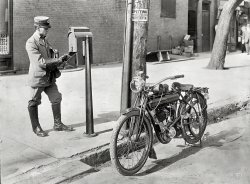
- Gee's Bend: 1937
- ... full project was developed there including schools, store, blacksmith shop and cooperative cotton gin.
The photo shows the "swept ... Posted by Dave - 07/30/2012 - 10:49am -
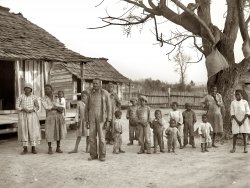
- Black Earth: 1941
- ... But go to most any farm, construction or logging site or blacksmith, woodshop, you can still see them. Right or wrong, I've judged a ... Posted by Dave - 03/20/2020 - 12:45pm -
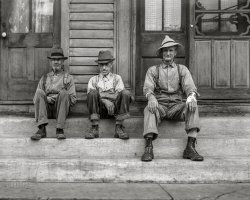
- Surrey With the Fringe on Top: 1908
- ... such as a bulldozer and a backhoe.
So I was in the Blacksmith's shop, and the Smith was doing his demos of fashioning various ... Posted by Dave - 07/19/2012 - 10:22pm -
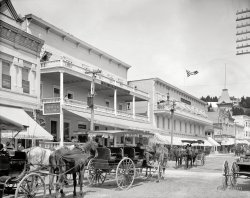
- Hyattsville Hardware: 1940
- ... the Hyattsville Hardware building originally housed a blacksmith shop and a carriage maker. The Hyattsville Hardware Company opened ... Posted by Dave - 06/10/2016 - 9:01pm -
![Hyattsville Hardware: 1940 Prince George's County, Maryland, circa 1940. "Electric Institute of Washington, Potomac Electric Power Co. Stores of electric dealers. Hyattsville Hardware." 8x10 inch acetate negative by Theodor Horydczak. View full size.
5121 Baltimore AvenueStill standing.
[Did they change the name of the street? - Dave]
Dave - I'm not sure. I did an initial search using Maryland Ave. as a reference but couldn't find anything. I thought maybe the street was an extension of Maryland Ave. coming out of DC, but it didn't seem to line up (even considering possible street realignments over the years) and that it is actually the extension of Rhode Island Ave. I haven't done a more extensive search if any street name changes have occurred. Using the name of the store, I was able to find the building through a reference to the current business.
Maryland No MoreIn 1925 Maryland Avenue was federally designated as Route 1, but there was also an area-wide street name change in the town in 1941 that eliminated many of the old historic street names.
Built in 1894, the Hyattsville Hardware building originally housed a blacksmith shop and a carriage maker. The Hyattsville Hardware Company opened here in 1914, and it has had several owners including Neuman Dudrow, the Norman brothers, and the Risden family. The store closed in 1990. The Franklin General Store opened in its place in 1992.
Now a great restaurant and craft beer venueFranklin's Restaurant on Route One is a popular meeting place for Hyattsville residents. In the taller of the buildings shown is a store with unusual toys, games, candies, wines, and cooking utensils.
My Sears kit house was delivered in two railroad cars to the Hyattsville Hardware store, which sits next to the train tracks, in 1926, and delivered to the building site by a horse-drawn wagon.
The funky vibe of Franklin's has influenced the Arts District improvement plan for the mile or so north of it on Route One. The many old auto repair stores and dealers there were replaced by attractive row homes and small businesses.
Westinghouse AutomealThe electric roaster in the window caught my eye. My 90+ years old aunt has one like that and uses it regularly.
If they don't got itYou don't need it. I wish I could shop in that store. I see lots of things I'd love to have.
From "Best Paint Made" to "Best Paint Sold" ?But originally from Burtis, Patterson, Sargent Co..
(The Gallery, D.C., Stores & Markets, Theodor Horydczak)](https://www.shorpy.com/files/images/SHORPY-5a44931u.thumbnail.jpg)
- Arkansas Travelers: 1938
- ... Seven children and eldest son's family. Father was a blacksmith in Paris, Arkansas. Son was a tenant farmer. 'We're bound for ... Posted by Dave - 05/20/2016 - 5:28pm -
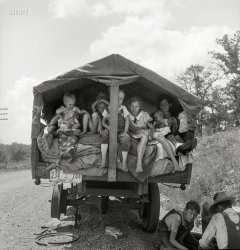
- In the Shop: 1926
- ... and adjusting departments. On the far side is located the blacksmith shop, a radiator department and test block for working on motors ... Posted by Dave - 09/11/2011 - 1:59pm -
![In the Shop: 1926 "Semmes Motor Co. garage, Washington." The LOC says 1916 or 1917 but the nearest car has a 1926 license plate. View full size. National Photo Company.
PoseurAt first I thought, "Whoa! That's some incredible photorealistic painting that somebody did on the side of that truck!" Then I realized that the words "The Hecht…" are on the side of the panel truck that's behind a pickup style truck, and the "photo" is really a guy standing there.
Full ServiceSemmes Motor Company was a very busy place. They had thier own radio station, WHAQ (AM 833). In the late teens they ran a bus service. They sold Dodge trucks, too.
Ideal Auto ServiceThe Semmes brothers (Raphael and Charles W.) opened the Congressional Garage at 623 Pennsylvania Avenue SE in 1910. Originally dealers for Wilcox trucks, they later became the major dealership for Dodge trucks and cars in Washington. They also ran several bus lines between Washington and southern Maryland.
The level of service appears quite progressive in regards to customer relations and standardized costs as evidenced by the following article:
Washington Post Nov 23, 1919
Ideal Auto Service
Semmes Motor Co. Plans Up-to-Date Methods for Breakdowns.
When alterations now under way and those under contemplation on the new Semmes Motor Company Service building at 613 G street [NW], purchased last week by C.W. Semmes, are completed, it is said the building will be one of the most complete of its kind in the country.
Six stories in height, it is fireproof throughout. Each floor contains 18,000 square feet of floor space. The two top floors are a present occupied by the government. The remaining four are occupied by the Semmes Motor Company, as a service station for Dodge cars, with the exception of a limited amount of space on the first floor, which is used by the Semmes Motor Line. A car owner can bring his car into this building, and no matter what he wishes to have done to it, his request can be complied with, without having to send the machine or any part of it out of the building.
The idea of service is perhaps carried a little further by this company than any other in Washington. On the first floor there is a finely appointed waiting room and information desk, as well as cashier. The owner brings his car into the building, is met by an employ to make note of what he wishes to have done to the car. At the same time the customer is informed just how much each job on the car will amount to. The cost system of each job on a Dodge car has been arrived at after careful study of the various kinds of work that is to be done on one of these machines.
...
The cost of parts of materials, if any were necessary, was known in advance, and the computing of the price to the customer for what he wanted done to his car has been worked out that is today a simple matter. If the task can be finished in a few minutes the customer can wait in the courtesy room, where he will find newspapers and magazines to help pass the time more quickly. If unable to wait, or the task is one that takes time, if he or she wishes, they will be sent home or to any part of the city they wish to go in a Dodge limousine, a courtesy car it is called the Semmes Motor Company. When the car is finished, if the customer wishes, the courtesy car is sent to bring him to get his or her own machine. The completed car is brought to the door of the courtesy room and the customer can be on his way.
For the services of the courtesy car no charge is made. Once in the building, the floor to which the customer's car is sent depends entirely upon the work to be done. The second floor is given over largely to heavy work, while on the third floor is the paint and trimming shop. The fourth floor contains the stockroom and the repair and adjusting departments. On the far side is located the blacksmith shop, a radiator department and test block for working on motors that have been overhauled and consequently very stiff. On the third floor is also an employees' lunchroom, where coffee is furnished free and other edibles furnished at actual cost. This is a facility that every employee and even C.W. Semmes, president of the firm, avails himself of.
...
The building is the largest service station in Washington and one of the largest for an individual car in the United States.
(The Gallery, Cars, Trucks, Buses, D.C., Natl Photo)](https://www.shorpy.com/files/images/32957u.thumbnail.jpg)
- Cotton Queen: 1940
- ... Nickey Brothers Lumber Company.
He had started out as a blacksmith when their deliveries were still made by horse & mule drawn ... Posted by Dave - 12/03/2013 - 4:23pm -
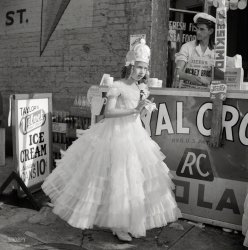
- Payne Service: 1939
- ... September 1939. "Combination filling station, garage, blacksmith shop, grocery store. Frank Petty, owner of the wagon, has just had ... Posted by Dave - 08/03/2019 - 1:43pm -
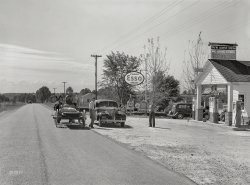
- Chez Shermour: 1910
- ... Hardware stores sold kits to make license plates and many blacksmith shops also made early plates. Wood, leather, and metal were all ... Posted by Dave - 09/30/2012 - 6:08am -
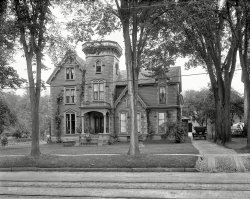
- Cove Fort, Utah: c.1940
- ... the West, including Kitchen, Bedrooms, Telegraph Office, Blacksmith Shop, etc. It's a great place to have a picnic and let the kids run ... Posted by bdj100 - 11/07/2014 - 6:52pm -
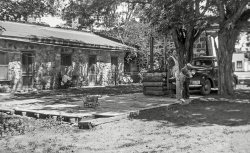
- Blacksmiths Peter and Harry Lawrence
- ... Lawrence, left, and his son Harry operated a welding and blacksmith shop in Erie, PA from the 1920s to 1948, when Peter died. They began ... Posted by u02bnpx - 07/11/2008 - 2:26pm -
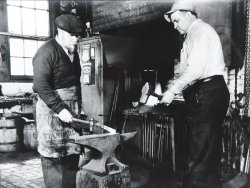
- Pascagoula: Circa 1910
- ... backyard about 1910. Leo Rohr, holding baby, was the town blacksmith.
(ShorpyBlog, Member Gallery) ... Posted by kfr - 05/14/2019 - 9:07am -
